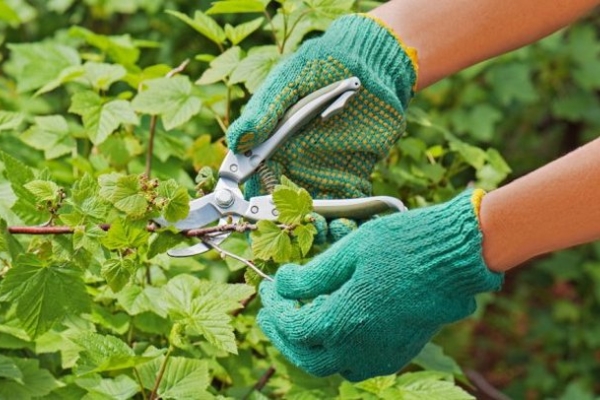Currant pruning is an agrotechnical technique that is needed for the proper development of fruit shrubs.
Understanding the goals, rules and subtleties of currant pruning, even novice gardeners will regularly receive good yields.
Table of contents
Trimming objectives
Starting pruning, should be aware of the purpose of this procedure. Technique pruning, depending on the task will vary.
Pruning currants carried out to:
- form the correct shape of the bush;
- clean shrubs from damaged and diseased branches;
- to power each branch to create the best conditions;
- rejuvenate the old bush.
Sanitary pruning - removal of branches damaged by infections and pests will help to improve the currants and increase yields.
Anti-aging pruning procedure allows you to save an adult plant, increase its productivity.
Mistakes made with any type of pruning can lead to diseases of a different nature, one-sided development of the bush and poor fruiting.
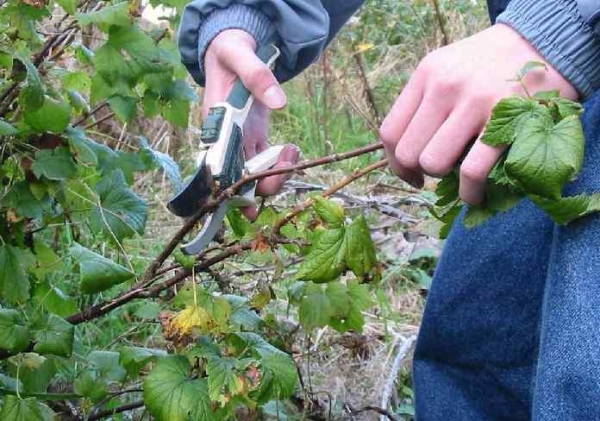
Timing
During a year allocate several periods for trimming currants. The procedure can be performed in spring, summer, autumn and even in winter.
The timing of trimming should be based. not on the convenience of the gardener, but on the period of vegetative development of the plant.
Is it necessary to trim in the spring?
In early spring, fruit bushes are at rest. Vegetation has not yet begun, there is no active sap flow in the tissues. This is the best time to trim a bush in spring.
The gardener has little time for the procedure in the spring. As soon as the buds begin to bloom en masse - the period of spring pruning is over.
If you do not follow this rule:
- slices will liberally secrete juice, which will not allow wounds to heal quickly;
- the risk of infection with fungal and bacterial infections increases;
- the bush will be sick for a long time, instead of increasing the leaf mass and forming fruit inflorescences.
In spring, any type of pruning can be done. Opportunities limit different climatic zones.
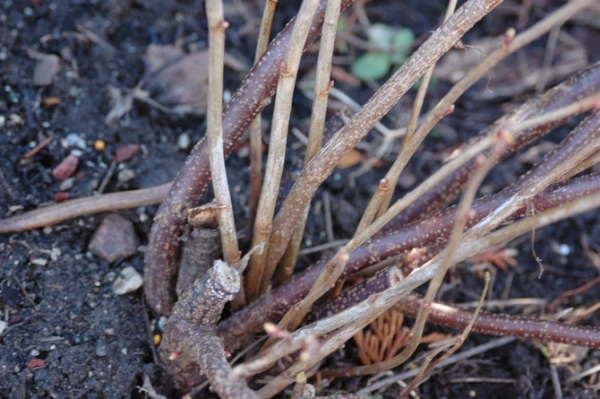
Sanitary pruning should be carried out in any type of climate. All broken and cracked branches are cut off. Partially removed shoots that are damaged by frost, sun, disease.
Shaping and rejuvenating trim held in this period only in the northern regions. In all others - these procedures are better to postpone to autumn.
Advantages of spring pruning:
- the strength of the plant is directed to more promising branches, the amount of harvest increases, the size of the berries increases;
- the lighting is evenly distributed throughout the vegetative mass, the ripening of the berries in the hands takes place almost simultaneously;
- diseases of the bush are prevented;
- growth of shoots is stimulated, which will bear fruit next year.
Spring pruning allows you to increase the yield of the current season and lay the foundation for the next year.
How to prune berry bushes in spring:
Is it possible to prune branches in summer?
At the very beginning of summer, especially if the spring was long and cold, you can re-sanitary pruning currant bushes. At this time, all the damaged branches are clearly visible.
In the spring, when sleeping buds, it is not always possible to determine which escape survived the winter well and which did not.
In the summer you need to cut dried shoots, as well as doing nip green increments. On the branches that were left without tops, side shoots will begin to develop.
Some gardeners in the summer spend thinning and shaping currants. Such pruning is applied as soon as all the berries are picked in August.
Cutting the bush after harvest:
- removal of branches older than five years;
- pruning deformed, underdeveloped shoots;
- destruction of sick and weak branches.

These actions do not have a unique assessment.. On the one hand, the illumination and ventilation of fruit branches are improved.
There is a place for the free development of annual shoots.Young growth in a timely manner protected from infections and pests.
On the other - increases the load on the bush. Pruning stimulates young shoots, at the same time, when the currant spends all the forces on the aging of wood and preparing for winter.
The movement of juice in this period is still active, wounds can stay wet for a long time. This is a gateway for infections of a different nature.
The shoots that will only begin to grow during this period will hardly have time to mature before the onset of cold weather. Damage in winter is inevitable.
Cutting in the fall - what is needed?
In the fall to pruning after the currant will shed the bulk of the leaves. The plant is preparing for winter, the movement of juices slows down. The selection of drops of juice on the cut suggests that autumn pruning start early.
In areas with a harsh climate, it is recommended to prune shrubs in spring. In autumn frosts can spoil the results of work: the tips of the branches will freeze, in the spring they will have to be removed.
Advantages of autumn pruning:
- longer period of work;
- preparing the plant for winter;
- help young shoots in nutrition and active development;
- the incentive to form a large number of replacement shoots next spring;
- bushes rid of pests and diseases;
- conditions are created for good fruiting next year.
In the autumn in the central regions carrying out the forming, rejuvenating scrap. At the same time, branches damaged by summer work with bushes are cut off.
Pruning of black currant bushes in autumn:
In winter
Some gardeners do winter pruning from November to mid February. This is possible under the condition of year-round access to the site. Sections are carried out on frozen branches.
It is impossible to say unequivocally when it is better to cut currants, in spring or autumn. Unlike the gooseberry, which buds start to bloom early, and complicate the spring pruning, currants later enter the growing season.
If it is impossible to get to the site while it is snowing, all pruning work with gooseberries has to be done in the fall.Currants gives you the opportunity to find time for pruning in each season.
Currant pruning should be done annually.. The main work is convenient to do in the fall. In the spring it will be necessary to carry out sanitary pruning, which will correct the effects of hibernating the winter.
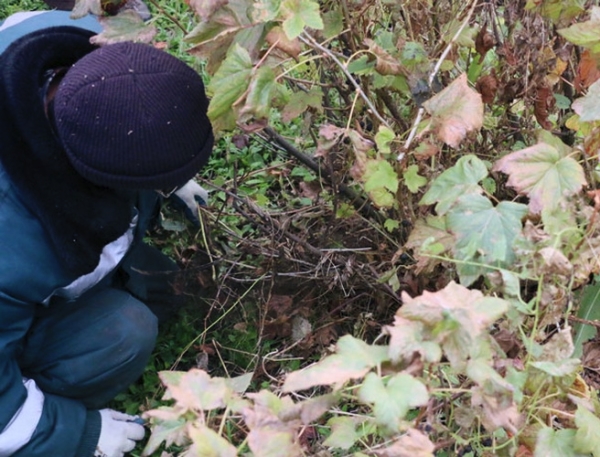
Technology and circuit
Depending on the purpose and type of currant different currant trimming technology is used.
Why do circumcision before planting?
Before cutting the currants before planting, it is necessary to study the technique of seedling formation.
Black currant
The one-year currant bush has 2–4 ramifications. When planting, each branch should be cut strongly.: two – three buds are left on the shoot. It is desirable to cut branches on the outer bud, then next year a wide bush will be formed.
By the fourth year of life fruit shrub will be fully formed.In the future, to maintain the form, he will need only supporting pruning.
Red and white
In the first year of life in white and red currants, three to four buds are left on each shoot. This allows you to increase the number of increments in the next season.
In the second year 3-4 strong branches are left, the rest are removed. You should pay attention to the uniform distribution of branches relative to each other.
In the future, carry out pruning in such a way so that two – three branches of each age are left on the bush. Pruning seedlings before planting should be carried out in accordance with the age of the plant.
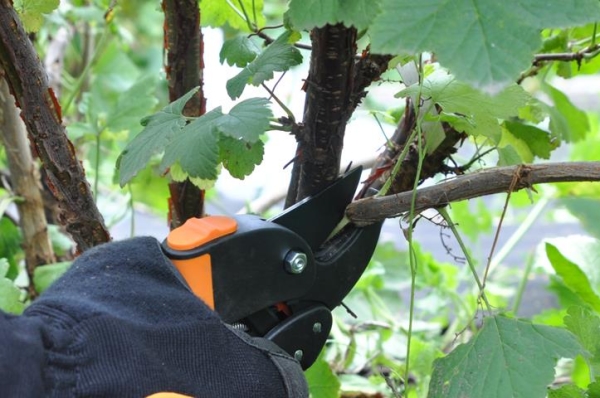
When to do rejuvenation of old shrubs
Anti-Aging Treatments Required black currant, starting from the fifth year of growth, and red and white - from the eighth. Work better in the fall.
There are four ways currant trimming: on the ring, on the kidney, with translation and nip.
Ring trimming applied with the complete removal of branches. In the procedure of rejuvenation in this way old, thick branches are cut. The escape is cut off at the base. Large wounds from such a cut should be treated with antimicrobials and covered with garden pitch.
Pruning on kidney allows not only to shorten shoots, but also to control the development of branching. The method is used for partial pruning of the branches. By trimming the kidney, facing the center of the bush, you can stimulate its density.
The cut made on the outer bud, on the contrary, will form shoots from the center. The second option improves the access of light to each kidney and provides currant airing.
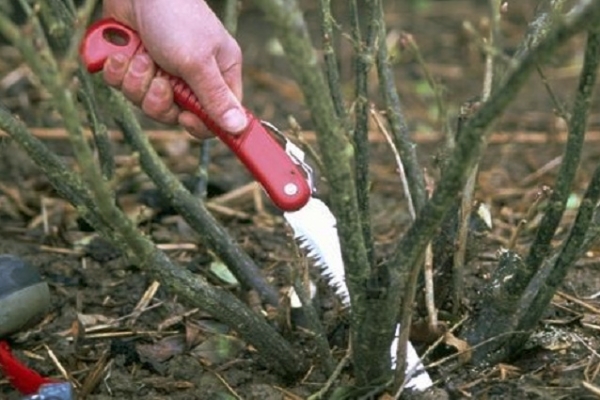
Pinch stimulate the growth of new shoots, regulate the amount of the crop.
One of the main methods of anti-aging treatments for red and white species - currant pruning with translation to strong branching. This is necessary on the old, but still fruitful branches.Also, the method is used if part of the branch is damaged.
They find a strong lateral abduction, with good potential for fruiting. The entire branch after branching is removed. This method can be used for partial rejuvenation of the bush.
If the shrub is badly running, rejuvenating pruning at a time should not be. Loss of a large percentage of the vegetative mass of the old bush can not survive.
Large unproductive branches should be cut in stages with an interval of a year.
Pruning of old and neglected currant bush:
Unusual trimming methods
The simplest - for beginners gardeners
This method does not require the gardener to determine the age of the branches. Any branch, the growth of which at the end of the season has not reached 15 cm, should be removed.
If the bush is heavily thickened, with this method, remove the extra annual branches.
Michurinskaya - for a good harvest
Some gardeners adhere to the principles of trimming “according to Michurin”, especially when growing berries for sale. This method is used on large plantations of skoroplodny varieties of black currant.
Technology:
- all bushes grow and bear fruit without pruning for the first five years;
- at the age of 5 - 6 years, half of the bushes in planting are cut down at the root and are well fed;
- after a year, about 20 of the grown shoots are left, the rest are removed;
- a year later, the process is repeated with the remaining 50% bushes;
- after mowing the bushes uprooted completely in two or three years, their place is taken by young plants.
This is a technology of intensive cultivation, allowing get a third more crop.
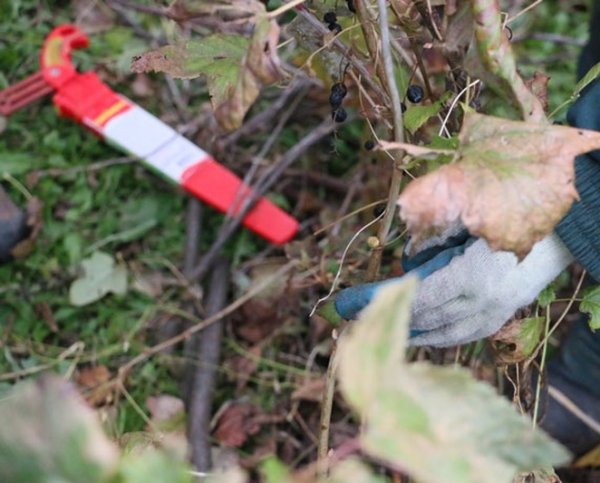
Standard forms: how to shape currants in fashion?
Hobby garden design reflected on the fruit bushes. Currant is no exception: its standard forms come into fashion.
Not all varieties of currants are suitable for creating a trunk. The main criterion in the selection of varieties - the minimum formation of shoots from the bottom of the bush.
Shtamba formation technology step by step:
- a stem is formed immediately after planting, side branches are cut at a height of 20-40 cm from the ground;
- two to three apical buds are left on the central shoot;
- in the development of the crown, a small tree is formed by summer nip;
- in the first year, shoots pinch, leaving two – three lower buds;
- in the second year, you need to cut that part of each branch that is longer than 10 cm;
- in the future annually cut branches at a distance of 20 cm from the stem;
- shtamb regularly cleaned.
How to produce autumn pruning
For pruning to be successful, the correct work sequence is necessary.
In the scheme of the autumn pruning can be divided into two blocks.. The first and third are carried out for all types of currants, the second - varies depending on the type of shrub.
Stage One: Sanitary
Before cutting any currant, you need to clean the bush:
- get rid of all broken and dry branches;
- they cut out shoots whose wood did not have time to mature: if such shoots are not removed, in winter they will be damaged by frost;
- cut off all the deformed shoots;
- remove the branches that are intertwined or grow to the center of the bush;
- destroy diseased branches: shoots affected by infection or pests should be burned;
- if a branch has grown far from the center or lies on the ground, it must also be removed.

Stage Two: Anti-Aging
Black currant
When cleaning is completed, go to the removal of old branches of black currant. When pruning should be remembered that shoots are the biggest crop at the age of two and three years, the bulk of the berries is formed on the central buds.
Based on this:
- on the black currant should cut branches over 5 years;
- If the bush is well formed and has more than 8 biennial shoots, you can prune branches older than three years;
- third shoots are cut from one-year shoots.
Removal of old low-yield branches contributes to the better development of fruit-bearing ones. Partial pruning promotes branching and an increase in flowering buds next season.
Red and white
Red and white currants have a longer fruiting period. At the age of five to eight years, the yield of branches is high.Flower buds are massively formed on the tops of these types of currants.
Based on this:
- all branches older than 8 years should be cut off at ground level;
- on a well-formed bush, no more than 12 shoots are left;
- the tops are removed only if there is damage.
Stage Three: Supportive
In the end, if the bush is still thickened, you can trim the extra branches. Trying to lighten the bush, you should remove extra branches from the center.
If the fruitful branches enough, shoots grown in the current year, you can cut.
How to care after
Pruning for currants is stressful for the plant. Especially for adult bushes, in which the regeneration process is weaker. After pruning currant needs feeding.
After spring pruning, shrub should be fertilized. comprehensively. Mineral supplements should contain trace elements of phosphorus, potassium, in equal amounts.
The proportion of nitrogen in the spring feeding increased. Experienced gardeners prepare fertilizers themselves, using superphosphate, potassium chloride, ammophoska, urea.

In the fall a lot of nitrogen does not need currants, for better aging of wood requires more phosphorus and potassium.
In addition to minerals, currant needs organic. Black currant reacts especially well to bio-fertilizers. When using manure, it is necessary that it be rotted.
Organics will fruitfully serve fruit bushes, if it is not just put in the root zone, but embedded in the soil. Cover the ground. When decomposing manure and humus emit a lot of nitrogen, so they should be made in the spring.
Properly chosen fertilizer contributes to the rapid healing of wounds from pruning.
Correct pruning - This is an understanding of the nature of the plant and help in its development. A thorough approach to pruning is a guarantee of a healthy, high-quality and large crop.
